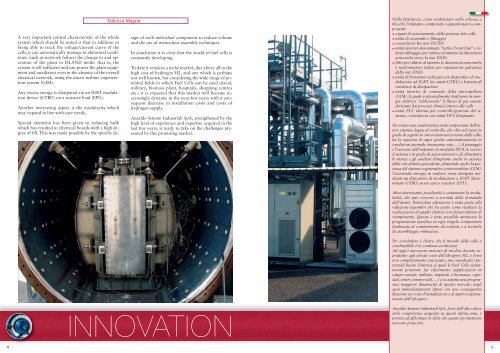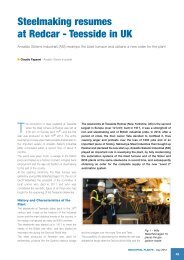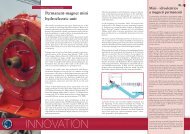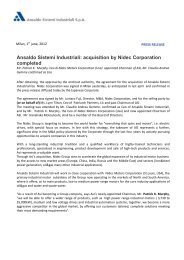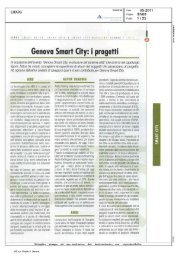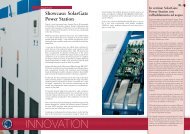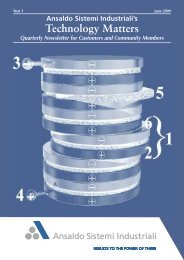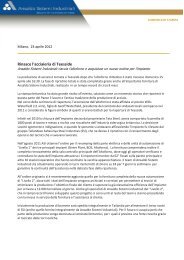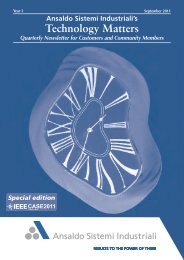Network Connection System for Fuel Cells - Ansaldo Sistemi Industriali
Network Connection System for Fuel Cells - Ansaldo Sistemi Industriali
Network Connection System for Fuel Cells - Ansaldo Sistemi Industriali
Create successful ePaper yourself
Turn your PDF publications into a flip-book with our unique Google optimized e-Paper software.
4<br />
A very important control characteristic of the whole<br />
system which should be noted is that in addition to<br />
being able to track the voltage/current curve of the<br />
cells, it can automatically manage in abnormal conditions<br />
(such as network failure) the change to and operation<br />
of the plant in ISLAND mode: that is, the<br />
system is self sufficient and can power the plant equipment<br />
and auxiliaries even in the absence of the overall<br />
electrical network, using the micro turbine cogeneration<br />
system (GIM).<br />
Any excess energy is dissipated via an IGBT modulation<br />
device (GTBU) on a resistive load (EPU).<br />
Another interesting aspect is the modularity which<br />
may expand in line with user needs.<br />
Special attention has been given to reducing bulk<br />
which has resulted in electrical boards with a high degree<br />
of fill. This was made possible by the specific de-<br />
Federico Magrin<br />
sign of each individual component to reduce volume<br />
and the use of meticulous assembly techniques.<br />
In conclusion it is clear that the world of fuel cells is<br />
constantly developing.<br />
To date it remains a niche market, due above all to the<br />
high cost of hydrogen H2, and one which is perhaps<br />
not well known, but considering the wide range of potential<br />
fields in which <strong>Fuel</strong> <strong>Cells</strong> can be used (naval,<br />
military, biomass plant, hospitals, shopping centres<br />
etc.) it is expected that this market will become increasingly<br />
dynamic in the next few years with a consequent<br />
decrease in installation costs and costs of<br />
hydrogen supply.<br />
<strong>Ansaldo</strong> <strong>Sistemi</strong> <strong>Industriali</strong> SpA, strengthened by the<br />
high level of experience and expertise acquired in the<br />
last few years, is ready to take on the challenges presented<br />
by this promising market.<br />
INNOVATION<br />
Nella fattispecie, come evidenziato nello schema a<br />
blocchi, l’impianto comprende i seguenti macro-componenti:<br />
• organi di sezionamento della potenza lato celle<br />
• unità di accumulo e filtraggio<br />
• convertitori Booster DC/DC<br />
• unità inverter denominata “Active Front End” e relativo<br />
filtraggio per ridurre al minimo le distorsioni<br />
armoniche verso la rete ENEL<br />
• filtri per ridurre al minimo le distorsioni armoniche<br />
e tras<strong>for</strong>matore trifase per separazione galvanica<br />
dalla rete ENEL<br />
• unità di frenatura realizzata con dispositivo di modulazione<br />
ad IGBT (ns. unità GTBU) e batteria di<br />
resistenze di dissipazione<br />
• unità inverter di comando della microturbina<br />
(GIM), la quale sostanzialmente tras<strong>for</strong>ma in energia<br />
elettrica “addizionale” il flusso di gas esausti<br />
derivanti dai processi chimici interni alle celle<br />
• unità PLC interna per controllo/gestione del sistema,<br />
e interfaccia con unità DCS d’impianto<br />
Da notare una caratteristica molto importante dell’intero<br />
sistema, legata al controllo, che oltre ad essere in<br />
grado di seguire la curva tensione/corrente delle celle,<br />
ha la capacità di saper gestire automaticamente in<br />
condizioni anomale (mancanza rete, …) il passaggio<br />
e l’esercizio dell’impianto in modalità ISOLA: ovvero<br />
il sistema è in grado di autosostenersi e di alimentare<br />
le utenze e gli ausiliari d’impianto anche in assenza<br />
della rete elettrica prevalente, sfruttando anche la presenza<br />
del sistema cogenerativo a microturbina (GIM).<br />
L’eventuale energia in esubero viene dissipata mediante<br />
un dispositivo di modulazione a IGBT (denominato<br />
GTBU) su un carico resistivo (EPU).<br />
Altra interessante peculiarità è certamente la modularità,<br />
che può crescere a seconda della domanda<br />
dell’utente. Particolare attenzione è stata posta alla<br />
riduzione ingombri che ha avuto come risultato la<br />
realizzazione di quadri elettrici con elevato fattore di<br />
riempimento. Questo è stato possibile attraverso la<br />
progettazione specifica su ogni singolo componente<br />
finalizzata al contenimento dei volumi, e a tecniche<br />
di assemblaggio minuziose.<br />
Per concludere è chiaro che il mondo delle celle a<br />
combustibile è in continua evoluzione.<br />
Ad oggi è ancora un mercato di nicchia, dovuto soprattutto<br />
agli elevati costi dell’idrogeno H2, e <strong>for</strong>se<br />
non completamente conosciuto, ma considerati i potenziali<br />
bacini d’utenza ai quali le <strong>Fuel</strong> <strong>Cells</strong> sicuramente<br />
potranno far riferimento (applicazioni in<br />
campo navale, militare, impianti a biomasse, ospedali,<br />
centri commerciali, …) ci si aspetta una progressiva<br />
maggiore dinamicità di questo mercato negli<br />
anni immediatamente futuri con una conseguente<br />
flessione sui costi d’installazione e di approvvigionamento<br />
dell’idrogeno.<br />
<strong>Ansaldo</strong> <strong>Sistemi</strong> <strong>Industriali</strong> SpA, <strong>for</strong>te dell’alto valore<br />
delle competenze acquisite in questi ultimi anni, è<br />
pronta ad affrontare le sfide che questo promettente<br />
mercato proporrà.<br />
5


